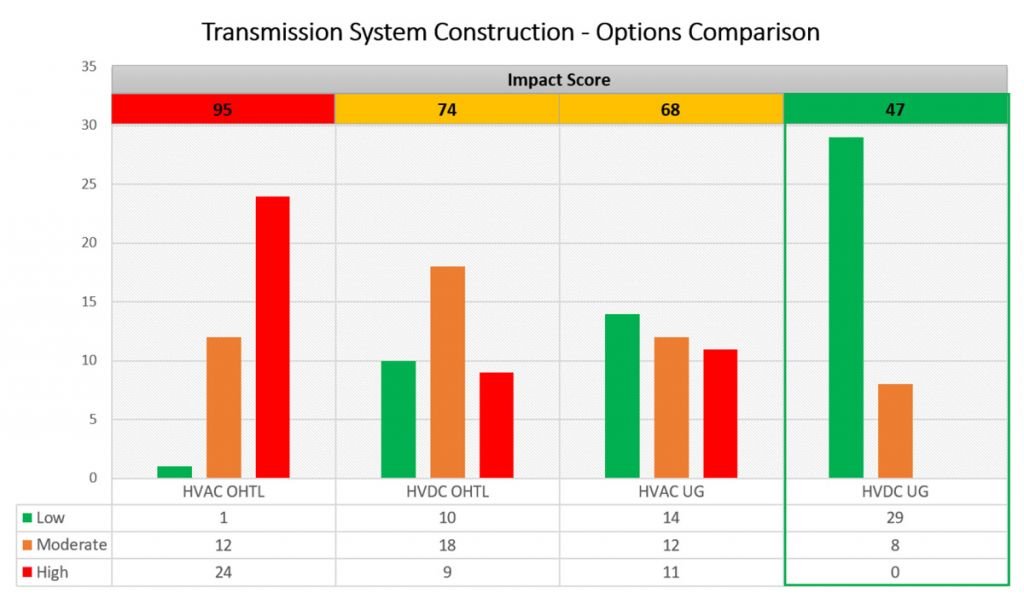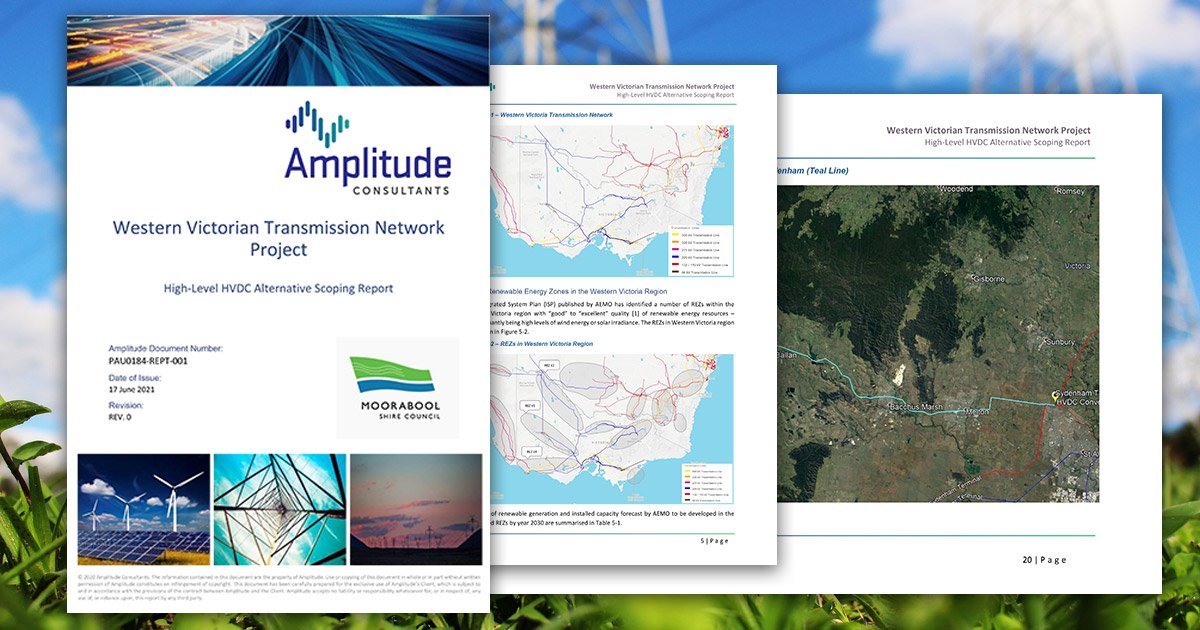High-Level HVDC Alternative Scoping Report
HVDC underground cables provide the lowest impact solution
Amplitude consultants were engaged by Moorabool Shire Council to investigate an alternative HVDC option utilising underground cable to the AEMO preferred Western Victoria Transmission Network Project (WVTNP) Option C2, which includes erection of new 220 kV and 500 kV overhead transmission lines (OHTL).
It was determined that not only is a HVDC system utilising underground cables a technically feasible alternative, but it is also likely to be more reliable and efficient for the movement of renewable energy to major centres whilst presenting significantly reduced impact to social and environmental factors.
A high-level comparison of AC and HVDC transmission options was performed in relation to the WVTNP to ascertain which transmission technology and overhead or underground construction method would present the least impact when considering a variety of criteria including technical, environmental and other risks.
The key points pertaining to the HVDC underground option being the lowest impact solution are as follows:
- Little to no risk of underground cables causing bush fires.
- Little to no risk of interruption to power transmission, or underground cables being affected, during bush fires or severe weather events. Power does not need to be switched off during bush fires to aid firefighting, and is highly unlikely to be disrupted due to smoke causing flashovers and potentially tripping the line.
- Little to no impact to access e.g. for emergency services or aviation operations.
- Minimal impact to private land or current land use once construction is completed as the easement could be designed to fit within existing road reserves.
- Significantly reduced impact to flora and fauna due to the possible location of the cable along roadways.
- No visual impact concerning the transmission line as the cables are buried underground.
- Equivalent or reduced visual and land-use impact from the converter station as it would be expected to occupy a relatively similar area as a typical AC terminal station with much of the equipment being housed indoors.
- No audible noise along the transmission line.
- Little to no electromagnetic field impacts.
The assessment results are presented in the figure below, which shows that the HVDC underground cable option carries the lowest impact out of the four options considered.

Amplitude reviewed the publicly available information and information that was provided by the Moorabool Shire Council to ascertain the parameters of the WVTNP Option C2. Amplitude then developed an alternative Base Case Concept HVDC System which could replace the proposed 220 kV and 500 kV AC overhead transmission lines between Bulgana Terminal Station and Sydenham Terminal Station with an entirely underground HVDC transmission system. The following points summarise some of the considerations and assumptions applied to the development of this option:
- Converter station locations were assumed to be close to the 220 kV lines near Bulgana, north of Ballarat, and in close proximity to the Sydenham Terminal Station.
- The underground cable transmission route from Bulgana to North Ballarat was assumed to predominantly follow the existing 220 kV overhead transmission line that runs from Bulgana Terminal Station to Ballarat Terminal Station. The route length was estimated to be approximately 88.5 km in length.
- An underground cable transmission route was estimated from North Ballarat to Sydenham, for the purpose of estimating cable route length and costs, using prudent avoidance techniques and routed mainly alongside existing roads and highways between Ballarat and Sydenham. The cable trench was estimated to be three meters wide and the route length to be approximately 78 km.
Amplitude developed a high-level cost estimate of this underground solution using publicly available sources, which came to circa $2.7Bn. This compares to around 5.7 times the cost of the AEMO preferred AC overhead WVTNP Option C2, rather than the up to 10 times more referenced by the AEMO Western Victoria Renewable Integration Project Assessment Draft Report (PADR). This cost estimate includes the overall engineer, procure and construct (EPC) cost of the HVDC converters and cables.
Of significance, the report identifies that the cost of the proposed overhead HVAC solution does not include the cost of mitigating risk anywhere near the extent that is inherently mitigated by the HVDC underground options. The HVAC cost is deficient because it does not factor in offsets for costs incurred as a result of predictable events such as catastrophic weather, or fire. Those same events have no impact upon a HVDC underground solution.
For the HVAC overhead solution to be engineered to achieve the same level of risk mitigation as the HVDC underground solutions, significant additional costs would need to be factored in making the total HVAC overhead cost significantly more expensive than currently estimated.
Applying a 40 year ‘whole-of-system-life’ perspective the cost difference between the current overhead proposal and the worst case HVDC underground solution amounts to around the price of one six-pack of beer, or one adult-price movie ticket, per year, for Victorian electricity customers. The MCHPA thinks this is good value when you consider the risk that is avoided.
To read the full report, download via the link below.

Join Now
Get Involved
The only way to make a difference is to get involved. It’s easy to sit back and wait for others to do something but when you are staring at 75-85m towers in a few years time, you will kicking yourself for not doing something when you had the chance. This is OUR only chance to stop these towers, so get involved now.
Welcome to the home of Darley Power Fight. A group of residents in Darley, Coimadai and Merrimu, united against high voltage transmission towers passing through our backyard. We came together through the realisation the transmission line will divide a narrow corridor between Darley and the Lerderderg State Park; altering landscape character, causing widespread damage to critical habitat for threatened species, increasing fire risk to the Park and thousands of residents, destroy our visual amenity, harm local agriculture and will impact businesses and property values. It will completely desecrate, in a few years, what nature has taken millions of years to create.


